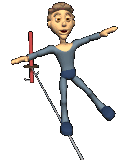In the feverish activity that is making circus history at Cole Bros. winter quarters, probably no department is busier these days than the horse barns, where training is followed on daily schedule comparable with the best and most exacting school.
Under the general supervision of Capt. H. J. McFarlan, veteran equestrine director, classes start promptly at 9 a.m., and continue throughout the morning. An hour's rest at noon, when clean, bright timothy hay and liberal portions of oats are served, and back again at one o'clock for a full afternoon which continues until darkness intervenes.
"This mercurial program is necessary --" says Capt. 'Mac.' as he is known familiarly about the stables, "because every horse here, excepting, of course Mr. Christiansen's Liberty act, are new and up to the time they arrived here, had never known what training was. Many, in fact, were purchased on the western ranges and never had a halter on them. And to teach horses to perform up to the standard set by Mr. Terrell and Mr. Adkins for the new Cole circus, means hard, conscientious work, every minute of every day."
It was Capt. McFarlan's reference to new, unbroken steeds that makes the results now seem in each of the several training rings, so remarkable.
Bronchoes Near Perfect
Let us move up to the north end of the big, 250-foot barn - to the ring where Jorgen M. Christiansen is breaking sixteen perfectly matched cream-colored westerners to duplicate the almost unbelievable feats of his eight famous Cremoline stallions, said to be the finest trained horses on earth.
These sixteen light dun animals with white manes and tails were roaming the wide open spaces of the great West some two months ago, when McFarlan set out to find them. He traveled by train, by auto, yes, even by airplane durng the search. With the famous Christiansen Cremolines as his specimen or type and color and conformity, he traveled approximately three thousand miles, hunting, dickering, buying. At a ranch three hundred miles north of Yellowstone Park, he purchased the first animal, and before he had completed his journey, he was in the Panhandle of Texas, having covered Montana, Wyoming, parts of South Dakota, Nebraska, Colorado and New Mexico. But he had the horses. And of all the sixteen, only one had ever been haltered, while but three had ever seen a barn.
Six weeks ago, they were turned over to Mr. Christiansen, the man who brought the famous Liberty Horses, which amazed this country in 1923, half way across Siberia, through a part of Russia during the Red Revolution, succeeded in reaching Poland after a 15-hundred mile trek, many times within sound of Bolshevick guns, and emerged finally victorious in the great Polish Circus at Warsaw.
Christiansen split the horses into teams-of-eight and went to work. The results he has obtained are outstanding, almost incomprehensable. It is doubtful indeed, if such a feat has ever before been accomplished in so short a period of time.
Highschoolers Dance
Moving down the barn, we find Capt. John Smith, in charge of the highschool group, - thoroughbreds from the Bluegrass country, parading, dancing, rearing, jumping; and lovely ladies sitting on them with a grace that would put a Cossack colonel to shame.
And these beautiful, trim, steeds, like their cream-colored neighbors have learned everything they know about tangoes and rhumbas in this short but intensive six-weeks course.
There's Cyclone, a beautiful dark chestnut stallion that makes your eyes sparkle in admiration as he goes through his several dance numbers, rears up erect and tapers off with a neat bow to one knee; his beautiful neck superbly arched, eyes aflash, nostrils distended. Then there's a dozen of his team-mates - horses that fulfill every tradition of the thoroughbreds that they really are.
And the Ponies
Then there's the pony ring under supervision of Capt. Merritt Belew. One sees these snappy little Shetlands run and jump, and wheel and caracole while shaggy Callies frolic and romp, ride and flop; and monkey jockeys hang on, chattering, weilding tiny crops in true Derby fashion. It's a spectacle that will stir the hearts of Americans from childhood through to dotage.
With the pony acts completed come those snooty little ducks. Tricksters, yes, and what stunts they have up their clownish sleeves.
Satire de luxe, with plenty of irony thrown in. They connive to rob you of your grouch; to turn the severe into the ridiculous. And they succeed with a bang.
Then the Workers
And of course, there are the old dobbins that are hitched to the shays with the small barred windows at the ends, where black, bewhiskered muzzles sniff to make you wonder what kind of cat or bruin or behemoth rules within. They are the work horses, mostly whites or dappled grays, menials you may call them, but they are just as dramatically woven into the warp and woof of a complete circus, as the gilded wagons, the plodding elephants or the roaring lions.
Yes there are horses, whites, creams, sorrals, bays, calicos and blacks. Bucking broncs that defy their riders. Broad backed, wide hipped equestrines so familiar in the bareback acts and sleek, trim, jumpers to which an ordinary fence would mean nothing at all.
They will all be there in plumes and spangles when the show sets sail for the 1935 run, opeing in Chicago on April 20th.
[The News-Sentinel, Saturday, January 19, 1935]
Tuesday, May 06, 2008
Horses
Labels: .circus.
Subscribe to:
Post Comments (Atom)














0 comments:
Post a Comment